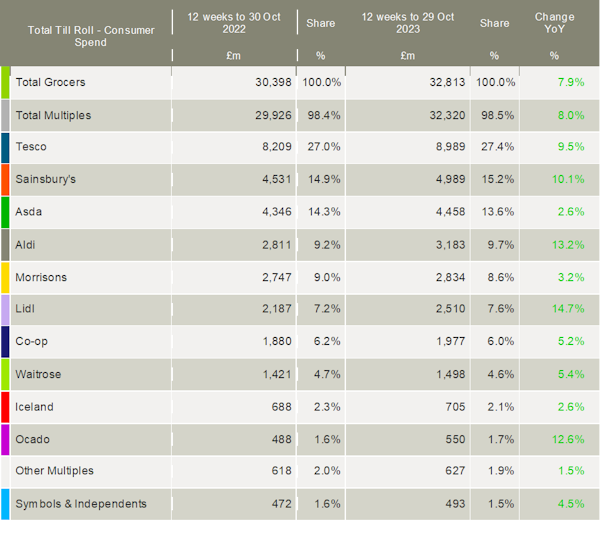Latest data from Kantar shows that grocery price inflation in the UK has fallen below 10% for the first time since July 2022 and now sits at 9.7%. Take-home grocery sales over the same four-week period to 29 October rose by 7.4% year-on-year.
“Grocery price inflation has finally dropped into single digits after 16 months of double-digit growth, marking a big milestone for the British public and retailers,” said Fraser McKevitt, head of retail and consumer insight at Kantar.
“While the drop to 9.7% is positive news and something of a watershed, consumers will still be feeling the pinch. We’re only seeing year-on-year price falls in a limited number of major categories, including butter, dried pasta and milk.”
Kantar noted that retailers were continuing to look at ways of softening the blow for shoppers, including upping the ante on promotions. Every one of the leading grocers increased the proportion of sales through deals versus last year, which is something that has only happened on one other occasion in nearly ten years. Consumer spending on promotions reached 27.2% of total grocery sales – the highest level the industry has seen since Christmas last year. This compares to October last year, when this figure was less than a quarter.
Meanwhile, shoppers are continuing to manage their grocery spending by trading down on the items they put into their baskets. McKevitt commented: “Own-label lines have grown ahead of their branded counterparts every month since February 2022, with the latest four weeks showing a sales boost of 8.0% for these lines. However, the picture may well change as we go headlong into the festive period when shoppers typically turn more to brands. The gap between own-label and branded goods is at its narrowest since spring last year. Branded sales increased by 6.7% in the latest month, raising the distinct possibility that they will push ahead by Christmas.”
The battle for Christmas spend is expected to be particularly fierce this year, with traditional shopping demographics and stereotypes being thrown out of the window by the cost of living crisis. McKevitt said: “The typical customer walking through the doors of the discounters is now representative of the country as a whole, with 54% of Aldi and Lidl’s sales coming from the more affluent ‘ABC1’ social group – close to the national average of 55%. Discounters are making their mark in frozen items and fresh groceries like meat and veg, with these categories constituting a higher proportion of their sales than the traditional retailers.”
The Kantar data shows that Lidl was again the fastest-growing retailer this month, with its sales over the 12 weeks to 29 October up by 14.7%, lifting its share by 0.4 percentage points to 7.6%. Aldi sat beside Waitrose as one of only two grocers to increase its number of shoppers yearly, attracting 207,000 more customers than last year, driving its sales up by 13.2%.
Sainsbury’s was the fastest-growing traditional supermarket this month, with a 10.1% sales increase, boosting its market share to 15.2%. Tesco gained share for the fourth consecutive month to take 27.4% of the market, an increase of 0.4 percentage points versus a year ago, after its sales growth reached 9.5%.
Morrisons recorded its seventh consecutive month of sales growth (+3.2%), but its market share remains well down on last year. Asda recorded the slowest growth amongst the leading chains, up just 2.6%.
Meanwhile, Co-op’s sales grew by 5.2%, the fastest rate since March 2021. Its market share stands at 6.0%, though in baskets that are less than £20, this figure jumps to 16.9%.
 NAM Implications:
NAM Implications:
- Single-digit inflation i.e. prices still going up, but more slowly.
- At 27% spend on promoted products, those not promoting are missing a trick.
- Ditto own-label i.e. if you don’t find ways of supplying own-label, rivals may benefit.
- Standout has to be Aldi & Lidl growing at the expense of traditional mults…
- …with the real stinger that they are pulling in ABC1 traffic, possibly habit-forming in the medium term?



